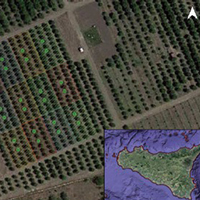Long-term monitoring of deficit irrigation regimes on citrus orchards in Sicily

Published: 23 December 2021
Abstract Views: 1051
PDF: 479
HTML: 31
HTML: 31
Publisher's note
All claims expressed in this article are solely those of the authors and do not necessarily represent those of their affiliated organizations, or those of the publisher, the editors and the reviewers. Any product that may be evaluated in this article or claim that may be made by its manufacturer is not guaranteed or endorsed by the publisher.
All claims expressed in this article are solely those of the authors and do not necessarily represent those of their affiliated organizations, or those of the publisher, the editors and the reviewers. Any product that may be evaluated in this article or claim that may be made by its manufacturer is not guaranteed or endorsed by the publisher.
Similar Articles
- Lorenzo Picco, Luca Mao, Emanuel Rigon, Johnny Moretto, Diego Ravazzolo, Fabio Delai, Mario Aristide Lenzi, An update of the sediment fluxes investigation in the Rio Cordon (Italy) after 25 years of monitoring , Journal of Agricultural Engineering: Vol. 43 No. 3 (2012)
- Maria Lisa Clodoveo, Tiziana Dipalmo, Cristina Schiano, Domenico La Notte, Sandra Pati, What’s now, what’s new and what’s next in virgin olive oil elaboration systems? A perspective on current knowledge and future trends , Journal of Agricultural Engineering: Vol. 45 No. 2 (2014)
- Timothy Denen Akpenpuun, Qazeem Opeyemi Ogunlowo, Wook-Ho Na, Prabhat Dutta, Anis Rabiu, Misbaudeen Aderemi Adesanya, Mohammadreza Nariman, Ezatullah Zakir, Hyeon Tae Kim, Hyun-Woo Lee, Dynamic neural network modeling of thermal environments of two adjacent single-span greenhouses with different thermal curtain positions , Journal of Agricultural Engineering: Vol. 55 No. 2 (2024)
- Qazeem Opeyemi Ogunlowo, Adedayo Afeez Azeez, Wook Ho Na, Anis Rabiu, Misbaudeen Aderemi Adesanya, Ezatullah Zakir, John Ademola Ijadunola, Bukola Olanrewaju Afolabi, Babajide Saheed Kosemani, Titus Adeyinka Ilori, Hyun-Woo Lee, Analysis of microclimate temperature and relative humidity distribution of local poultry house in a subtropical area of Nigeria , Journal of Agricultural Engineering: Vol. 55 No. 2 (2024)
- Vincenzo Bagarello, Andrea De Santis, Giuseppe Giordano, Massimo Iovino, Source shape and data analysis procedure effects on hydraulic conductivity of a sandy-loam soil determined by ponding infiltration runs , Journal of Agricultural Engineering: Vol. 48 No. 2 (2017)
- Melis Inalpulat, Monitoring and multi-scenario simulation of agricultural land changes using Landsat imageries and future land use simulation model on coastal of Alanya , Journal of Agricultural Engineering: Vol. 55 No. 1 (2024)
- Tiziana Bisantino, Vincenzo Pizzo, Maurizio Polemio, Francesco Gentile, Analysis of the flooding event of October 22-23, 2005 in a small basin in the province of Bari (Southern Italy) , Journal of Agricultural Engineering: Vol. 47 No. 4 (2016)
- Monica Parlato, Simona M.C. Porto, Giovanni Cascone, Raw earth-based building materials: An investigation on mechanical properties of Floridia soil-based adobes , Journal of Agricultural Engineering: Vol. 52 No. 2 (2021)
- Luigi Cavazza, Adriano Guarnieri, Angelo Fabbri, Chiara Cevoli, Giovanni Molari, Theoretical and experimental study on mechanical characterisation of a water drop impact on a solid surface , Journal of Agricultural Engineering: Vol. 47 No. 1 (2016)
- Antonio Guiso, Alessandro Parenti, Piernicola Masella, Lorenzo Guerrini, Fabio Baldi, Paolo Spugnoli, Environmental impact assessment of three packages for high-quality extra-virgin olive oil , Journal of Agricultural Engineering: Vol. 47 No. 4 (2016)
<< < 3 4 5 6 7 8 9 10 11 12 > >>
You may also start an advanced similarity search for this article.

 https://doi.org/10.4081/jae.2021.1193
https://doi.org/10.4081/jae.2021.1193







